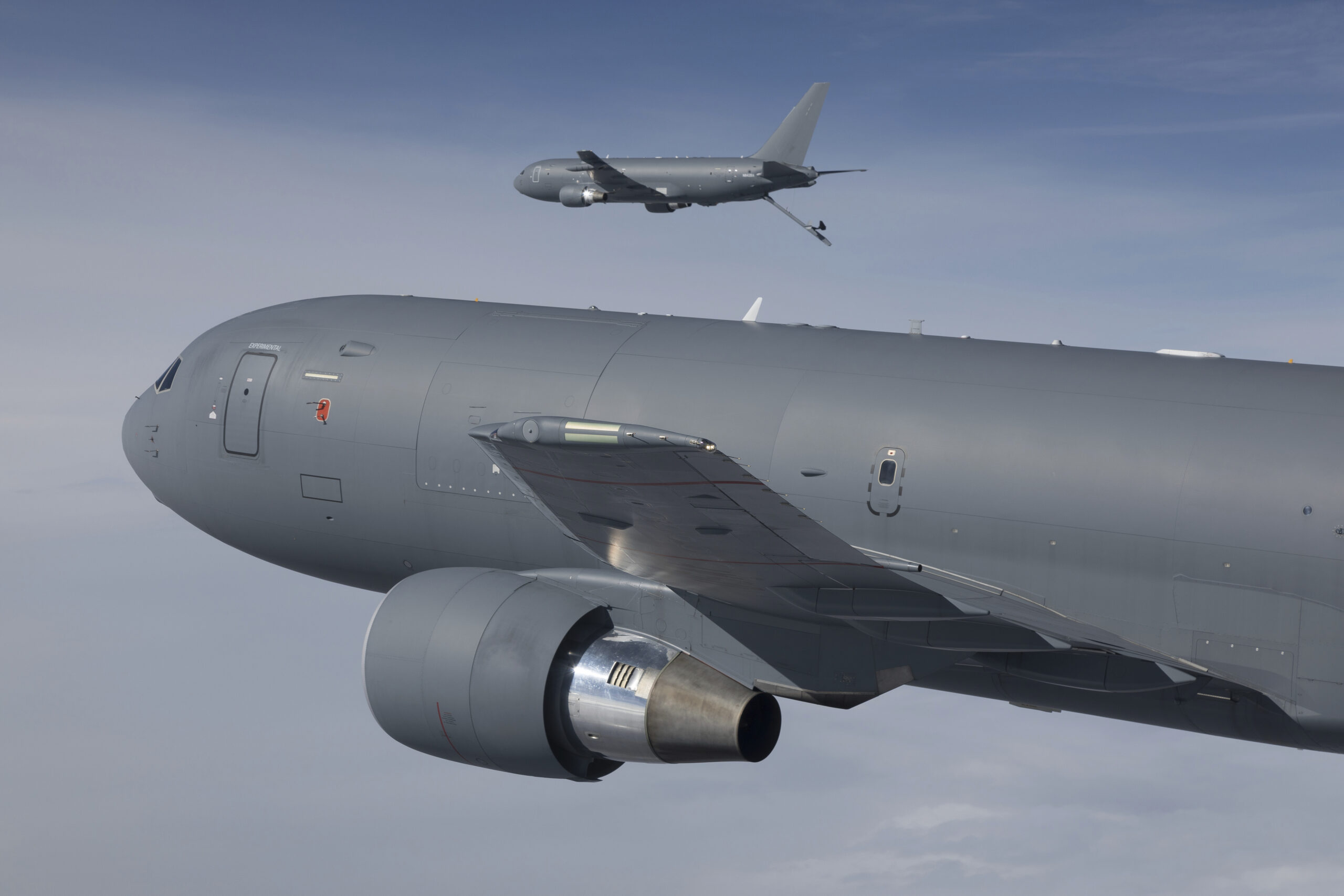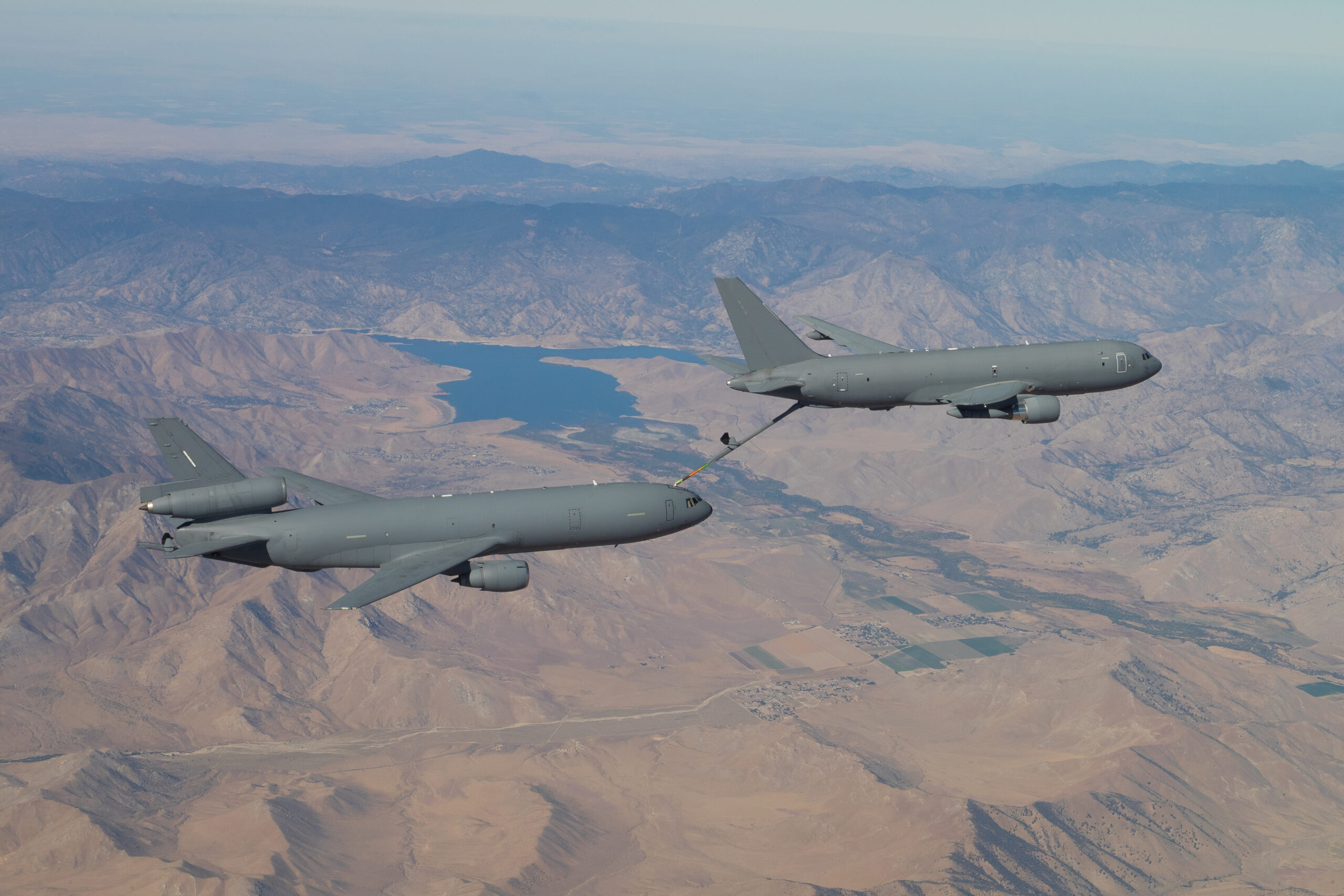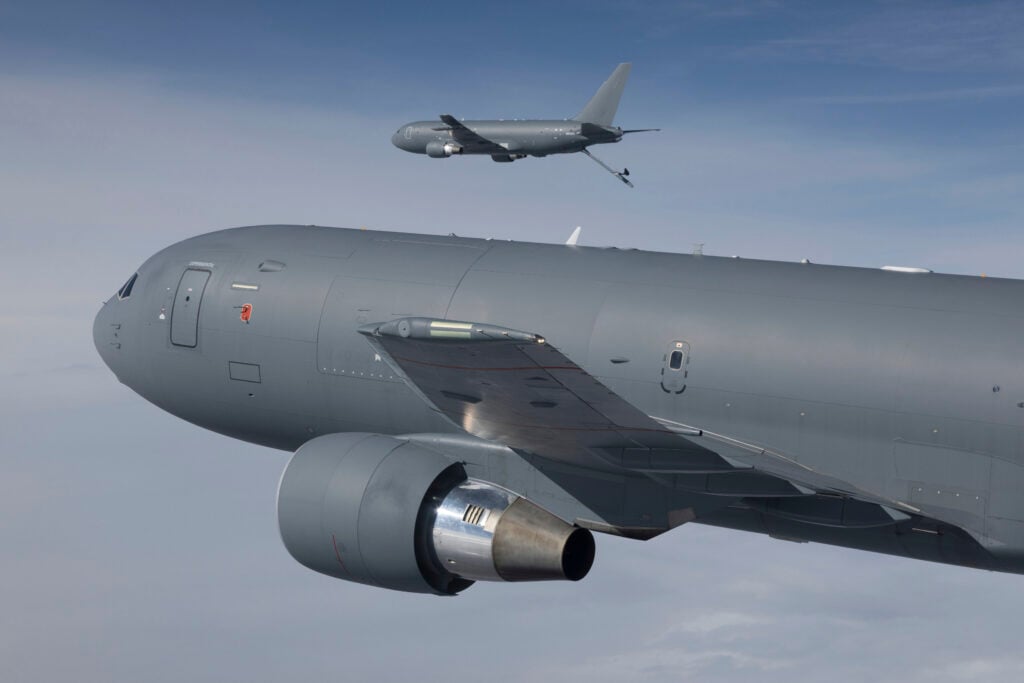
As more and more KC-46As enter service, global operators benefit from the economies of scale in operations, maintenance, training and support, allowing them to focus more resources on continuing to evolve the next-generation aerial refueling capabilities of the Pegasus. (Boeing photo)
Since the first KC-46A delivery in 2019, service members operating the Pegasus tanker around the globe have demonstrated its unmatched next-generation multi-mission aerial refueling capability, proving that the KC-46A has become a “game changer” for U.S. and allied warfighters.
Here are the facts about the KC46A Pegasus today:
The KC-46A is operational and deployed globally.
Approved for global combat operations in September 2022, the KC-46A is delivering fuel, data, and multi-mission capability around the globe. It’s been proven in combat and provides millions of pounds of fuel each month to U.S. and allied receivers.
The KC-46 continues to demonstrate its unparalleled capabilities, including in crucial exercises such as Red Flag 23 support in INDOPACOM. Globally, operators are also proving the platform’s interoperability with joint and allied forces, including war-fighting training scenarios conducted as part of Talisman Sabre 23.
With 153 KC-46As on contract globally and more than 80 in service around the world, the Pegasus provides aerial refueling and multi-mission versatility from a growing number of strategically important bases. In 2023, California’s Travis Air Force Base (“The Gateway to the Pacific”) became the sixth main operating base for the Pegasus. In January 2024, Selfridge Air National Guard Base was announced as a future base for the KC-46A, to follow MacDill Air Force Base in Florida. Lawmakers hailed the announcement, calling the KC-46A fleet “next-generation aircraft that will strengthen American defense operations and capabilities for future threats, particularly as we prepare for potential conflicts in the Indo-Pacific.”
The KC-46A is purpose-built for emergent, dispersed global conflict – and already combat-proven.
The KC-46A is the only commercial derivative aerial refueler that’s built from day one to be a combat tanker. With survivability features including, nuclear, biological and chemical warfare hardening, a Tactical Situational Awareness Suite, flight deck armor, radio frequency threat detection, and infrared missile countermeasures, the Pegasus can protect itself and the fleet. There is no other commercial derivative tanker in the world that matches the KC-46’s survivability.
The KC-46A is also designed for dispersed Agile Combat Employment from smaller, austere air bases throughout the operational theater, enabling more fleet fuel capacity and multi-mission capability where it is needed for warfighters. With more booms in the air on station through the battlespace, fighters and other aircraft spend more time at the point of attack and less in transit to and from the tactical edge.
In 2022, the KC-46A completed its first operationally-tasked combat mission, refueling two F-15E Strike Eagles assigned to the 335th Expeditionary Fighter Squadron.

The advanced KC-46A—shown here refueling a KC-10 Extender—continues to expand the capacity and capability of the aerial refueling fleet to deliver fuel and data throughout the operational theater. (Boeing photo)
The KC-46A is the most advanced multi-mission tanker in the world.
In addition to aerial refueling and unmatched rapid conversion for multi-mission cargo, personnel, and aeromedical transportation, the KC-46A provides “game-changing” battlespace tactical situational awareness to the crew and fleet with communications and data connectivity that do not exist on traditional tankers.
A Block 1 upgrade agreement signed in 2023 will enhance the aircraft’s data connectivity and situational awareness with additional line-of-sight and beyond-line-of-sight communications technologies, including antijamming and encryption features.
Boeing’s Pegasus delivers more fuel at all ranges and from shorter runways, and also carries three times more cargo pallets, up to twice as many passengers, and over 30 percent more aeromedical evacuation patients than its predecessor, the Boeing-built KC-135.
Continuing to evolve the KC-46 program is the fastest way for the U.S. and allies to increase fleet aerial refueling capacity and next-generation capability.
Thanks to a close partnership with the service and Boeing’s significant investment, the KC-46 program has a path to closing all development risks, including all remaining Category 1 deficiencies, well in advance of the continuation of the U.S.’s KC-135 recapitalization effort.
In turn, Boeing’s KC-46 program and military operators can focus their collaborative efforts and resources toward the continued evolution of the platform with next-generation aerial refueling systems capabilities to meet the emerging needs of the mission in the face of global threats. In addition, more U.S. and allied resources can be devoted to other operational needs, such as next-generation air dominance efforts and resilient basing.
The KC-46 program production system is a crucial part of the American military industrial base.
37,000 Americans contribute each day to supplying, manufacturing, and supporting the KC-46 program. Those jobs are economically vital for the country, and the skilled workforce across 43 states also ensures the nation’s military production resilience in the face of emergent and uncertain threats around the globe.
There are now more KC-46A tankers operating globally than any other tanker except the KC-135, and Boeing and its supply chain continue to produce more KC-46As each year.
Numerous U.S. armed services veterans like Kareem Foster and retired airman Aaron Reed continue their contribution to the nation by supporting the KC-46 program. Nearly one in six of Boeing’s U.S.-based workforce self-identify as veterans, enriching the collaboration that Boeing has with the service members it supports. The veterans who support the KC-46 provide crucial experience and insights that benefit the operators they served with.
Reed said, “The KC-46 Program was my opportunity to pay back the Airmen that I served with, the Airmen I haven’t served with, and the Airmen that are to come.”
Winning won’t wait
Global operators continue to demonstrate what makes the combat-proven KC-46A the world’s most advanced multi-mission aerial refueler. The KC-46 program has established U.S. production that reinforces the American industrial base, as well as proven current global operations, training, and maintenance support. Those crucial advantages for the warfighter make the KC-46A the fastest and most cost-effective way for the U.S. and its allies to field additional aerial refueling capacity and capability—and avoid an extraordinary cost and schedule risk for the continued recapitalization of the aging KC-135 fleet at a perilous time for global stability.


